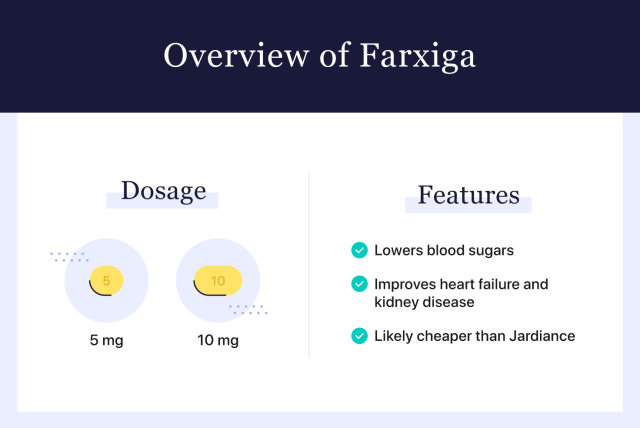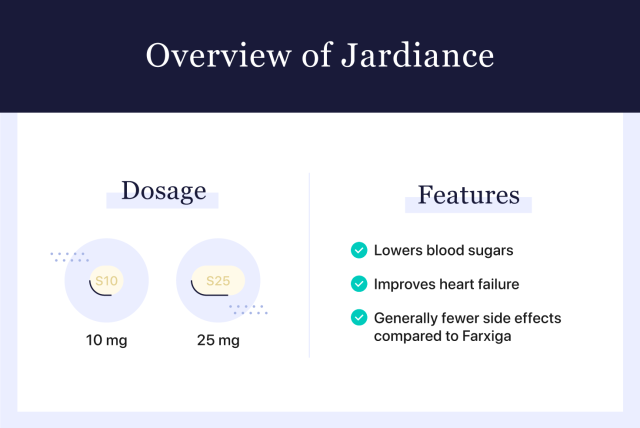Farxiga vs. Jardiance: A Comprehensive Side-by-Side Comparison
Farxiga and Jardiance are two medications that are used to treat Type 2 diabetes. They both belong to a class of drugs known as sodium-glucose cotransporter-2, or SGLT2 inhibitors, which prevent the kidneys from reabsorbing glucose and releasing it into the blood.

Farxiga vs. Jardiance: An Overview
The main difference between these two sodium-glucose cotransporter-2 inhibitors is that the active ingredient in Farxiga is dapagliflozin, while the active ingredient in Jardiance is empagliflozin. While both of these medications are effective at lowering blood sugar levels, there are some differences in active ingredients, secondary uses and potential side effects.
Pros and Cons
| Farxiga | Jardiance | |
|---|---|---|
| Class | SGLT2 inhibitor | SGLT2 inhibitor |
| Active ingredient | Dapagliflozin | Empagliflozin |
| Manufacturer | AstraZeneca | Boehringer Ingelheim |
| Dosage | 5-10 mg | 10-25 mg |
| Cost without insurance | $17.88 per pill | $18.56 per pill |
| Primary function | Treats Type 2 diabetes | Treats Type 2 diabetes |
| Secondary function(s) |
|
|
| Pros |
|
|
| Cons |
|
|
Active Ingredients
While both Farxiga and Jardiance are classified as SGLT2 inhibitors, they differ in active ingredients. The active ingredient in Farxiga is dapagliflozin, while the active ingredient in Jardiance is empagliflozin. Although they are both effective in managing Type 2 diabetes, there are a few differences in their uses.

Dosage and Uses
Farxiga comes in 5 mg and 10 mg pills, while Jardiance comes in 10 mg and 25 mg pills. The dosage for each medication depends on the condition it is meant to treat. Specific dosing information is as follows.
Treating Type 2 Diabetes
When taking Farxiga for Type 2 diabetes, it is recommended that adults start with 5 mg per day, with further increases as recommended. The dosage for children using this medication must be determined by a doctor.
When taking Jardiance for Type 2 diabetes, it is recommended that adults start with 10 mg per day, with further increases as recommended.
Lowering the Risk of Heart Failure
Both medications can be prescribed to lower the risk of heart failure in individuals with or without Type 2 diabetes.
When taking Farxiga to lower the risk of heart failure, 10 mg per day is the recommended dose.
When taking Jardiance to lower the risk of heart failure, 10 mg per day is also the recommended starting point, with an optional increase to 25 mg if approved by a doctor.
Lowering the Risk of Kidney Disease
Farxiga is also approved to help treat kidney disease and to lower the risk of heart failure in those with chronic kidney disease. When taking Farxiga for this purpose, 10 mg per day is the recommended dose.

Side Effects Comparison
Below are a few notable side effects found with both Farxiga and Jardiance. It is important to note that this is not a complete list, and you should consult with your doctor for more information.
| Frequency | Farxiga | Jardiance |
|---|---|---|
| Common |
|
|
| Less common |
|
|
| Rare |
|
|
Farxiga and Jardiance have similar side effects. However, there are a few key distinctions.
Farxiga has the potential for more side effects overall than Jardiance, and this is likely due to the active ingredients. Since Farxiga is approved to treat chronic heart failure and kidney disease in addition to Type 2 diabetes, the expanded efficacy may explain the additional side effects.
Additionally, Jardiance’s side effects primarily deal with the bladder or urinary tract. This is different from Farxiga, which has those same adverse reactions in addition to side effects dealing with the cardiovascular system.
Major Interactions
Below is an overview of the interactions users should be aware of before taking these medications.
|
Diuretics |
|
|
Overview |
Taking both empagliflozin and diuretics can increase the frequency and duration of urination, which can lead to volume depletion. Monitor volume depletion consistently if you’re taking or plan to take empagliflozin. |
|
Drug(s) affected |
Jardiance |
|
Insulin |
|
|
Overview |
The risk of hypoglycemia is greatly increased when an individual is using both insulin and Farxiga/Jardiance. If both insulin and Farxiga/Jardiance use is needed, plan to monitor blood sugar levels frequently; lower doses of insulin may be needed to prevent low blood sugars. |
|
Drug(s) affected |
Farxiga, Jardiance |
|
Lithium |
|
|
Overview |
Taking an SGLT2 inhibitor while also taking lithium can alter lithium concentrations in the body. If both SGLT2 inhibitor and lithium use are needed, plan to monitor lithium levels more frequently than normal. |
|
Drug(s) affected |
Farxiga, Jardiance |
|
Urine Glucose Test |
|
|
Overview |
The use of SGLT2 inhibitors can cause excess glucose excretions in the urine, which could result in positive urine glucose tests. If you monitor glucose levels with urine tests, find other methods if you take or plan to take SGLT2 inhibitors. |
|
Drug(s) affected |
Farxiga, Jardiance |
|
1,5-anhydroglucitol (1,5-AG) Assay |
|
|
Overview |
1,5-AG readings are unreliable when using an SGLT2 inhibitor. If you monitor glucose levels with 1,5-AG, find other methods if you take or plan to take SGLT2 inhibitors. |
|
Drug(s) affected |
Farxiga, Jardiance |
It’s important to be aware of these interactions when starting new medications. If you have doubts about any interactions with Farxiga or Jardiance, consult your doctor.
Warnings of Farxiga and Jardiance
Next, we will examine some of the warnings associated with Farxiga and Jardiance. This is not an exhaustive list, but a high-level overview of some of the top warnings. For a comprehensive list of warnings for either drug, consult your doctor.
Renal Impairment
When treating Type 2 diabetes, it’s important to regularly check kidney function when using either Farxiga or Jardiance. In patients with an estimated glomerular filtration rate (eGFR) < 30ml, use of these medications is either limited or not recommended. Additionally, Jardiance should not be used in patients who are on dialysis.
Ketoacidosis
Rare cases of ketoacidosis have been reported in individuals who are using Farxiga or Jardiance. It is recommended that individuals who experience nausea, vomiting, difficulty breathing or unusual exhaustion while on either medication should be tested for ketoacidosis immediately.
Volume Depletion
Fluid and sodium loss from blood volume, also known as volume depletion, can occur with the use of either Farxiga or Jardiance. This may include a drop in blood pressure or dehydration. If volume depletion is detected, individuals should discontinue use of these medications until the symptoms have been corrected.
Elderly
Elderly individuals are more at risk for volume depletion and renal impairment. Therefore, these patients should be monitored carefully when using either of these medications.
Pregnancy
It is advisable to withhold the use of Farxiga or Jardiance as soon as pregnancy is detected. While human trials have not been conducted, animal studies have found these medications to cause adverse effects during the second and third trimester of pregnancy.
When to Talk to Your Doctor
If you are interested in either Farxiga or Jardiance, the next step is to talk to your doctor. Although these medications are similar, you may have specific risk factors or preexisting conditions that make one or the other more suitable for you. Always consult with a medical professional before starting new medications.
FAQs
Finally, we will detail a few frequently asked questions about Farxiga and Jardiance.
Can You Take Farxiga and Jardiance Together?
It is not recommended to take Farxiga and Jardiance together. While these drugs have not been found to adversely react with each other, it is advised to only take one of these medications at a time.
Is Farxiga or Jardiance Cheaper?
Farxiga is slightly less expensive than Jardiance. Without insurance, the average cost per pill of Farxiga is $17.88, while the average cost per pill of Jardiance is $18.56.
Which Is Better: Farxiga or Jardiance?
The efficacy of Farxiga or Jardiance depends on individual circumstances. While these medications are similar, one may be better for an individual with certain preexisting health conditions. Therefore, it’s important to consult a doctor to determine which medication is right for you.
Calling this number connects you with a Drugwatch.com representative. We will direct you to one of our trusted legal partners for a free case review.
Drugwatch.com's trusted legal partners support the organization's mission to keep people safe from dangerous drugs and medical devices. For more information, visit our partners page.

